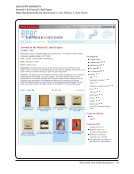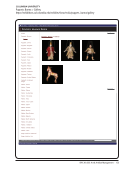28 · Survey Results: Survey Questions and Responses
11. If you use more than one tool, how do you determine which one to use for an item or collection?
Check all that apply. N=49
Nature of the collection (e.g., objects that are part of a manuscript collection may
be treated differently than objects in an art collection) 35 71%
Staffing/resources available for description 28 57%
Material type (e.g., photographs may be treated differently than sculptures) 24 49%
Size of collection 23 47%
Anticipated use 14 29%
Method of acquisition (e.g., purchase, donation, transfer) 5 10%
Other method 5 10%
Please specify the other method.
Artists’ books appear in the online catalog and on the web page.
As noted above, we use the simple spreadsheets to track orphans/items disassociated from their larger collections.
Inherent value or uniqueness. Also, condition and preservation costs.
Value (monetary) for audit issues.
We are in a period of transition, but are moving towards using AT for all materials. All collections get EAD and MARC
records.
Please enter any additional comments about choice of tools. N=9
All collections received have accession records in the AT and receive a collection-level MARC records more granular
description occurs in finding aids.
Almost always a matter of expediency and availability/knowledge of personnel (usually temporary and short-term).
Art and artifact materials are treated in a similar way. We rely on MARC records for description in order to integrate
information about visual material collections with the Library’s other holdings, although a Prints &Photographs Online
Catalog also combines MARC records in standalone databases with MARC records from the library’s ILS. For a particular
collection or acquisition, we plan for processing and cataloging by assessing the “Use, Value, and Viability.” We have
at least a summary description for each collection, increasingly supplemented by a container list that outlines broad
contents or provides an index. Material that is inherently fragile or difficult to handle safely is likely to receive item-level
listing or at least item-level tracking through a unique identification number, e.g., original drawings and photographic
negatives.
The collection is insufficiently documented. Over the years a little of everything has been used to keep track of it. The
most important tools are still the artist’s own manuscript inventories, old published lists and a catalogue raisonné of
prints. Volunteers and students have created non-EAD inventories and finding aids for a few very small parts of the
11. If you use more than one tool, how do you determine which one to use for an item or collection?
Check all that apply. N=49
Nature of the collection (e.g., objects that are part of a manuscript collection may
be treated differently than objects in an art collection) 35 71%
Staffing/resources available for description 28 57%
Material type (e.g., photographs may be treated differently than sculptures) 24 49%
Size of collection 23 47%
Anticipated use 14 29%
Method of acquisition (e.g., purchase, donation, transfer) 5 10%
Other method 5 10%
Please specify the other method.
Artists’ books appear in the online catalog and on the web page.
As noted above, we use the simple spreadsheets to track orphans/items disassociated from their larger collections.
Inherent value or uniqueness. Also, condition and preservation costs.
Value (monetary) for audit issues.
We are in a period of transition, but are moving towards using AT for all materials. All collections get EAD and MARC
records.
Please enter any additional comments about choice of tools. N=9
All collections received have accession records in the AT and receive a collection-level MARC records more granular
description occurs in finding aids.
Almost always a matter of expediency and availability/knowledge of personnel (usually temporary and short-term).
Art and artifact materials are treated in a similar way. We rely on MARC records for description in order to integrate
information about visual material collections with the Library’s other holdings, although a Prints &Photographs Online
Catalog also combines MARC records in standalone databases with MARC records from the library’s ILS. For a particular
collection or acquisition, we plan for processing and cataloging by assessing the “Use, Value, and Viability.” We have
at least a summary description for each collection, increasingly supplemented by a container list that outlines broad
contents or provides an index. Material that is inherently fragile or difficult to handle safely is likely to receive item-level
listing or at least item-level tracking through a unique identification number, e.g., original drawings and photographic
negatives.
The collection is insufficiently documented. Over the years a little of everything has been used to keep track of it. The
most important tools are still the artist’s own manuscript inventories, old published lists and a catalogue raisonné of
prints. Volunteers and students have created non-EAD inventories and finding aids for a few very small parts of the


















































































































































































